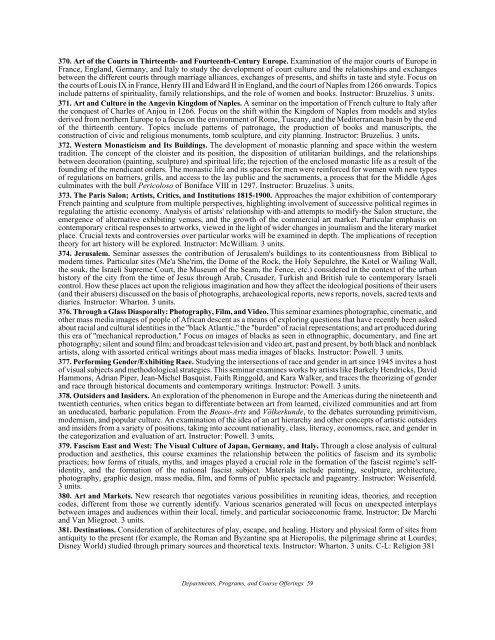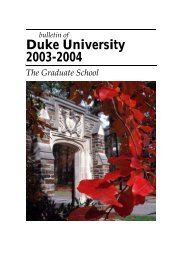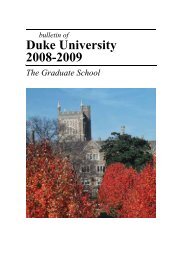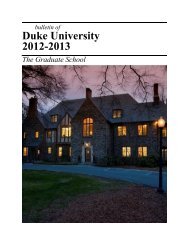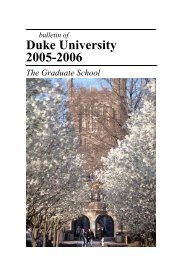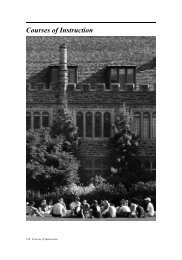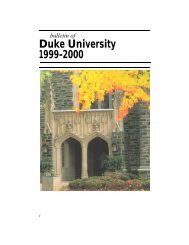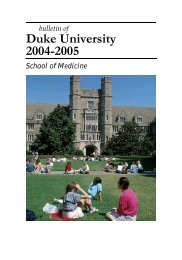Duke University 2009-2010 - Office of the Registrar - Duke University
Duke University 2009-2010 - Office of the Registrar - Duke University
Duke University 2009-2010 - Office of the Registrar - Duke University
Create successful ePaper yourself
Turn your PDF publications into a flip-book with our unique Google optimized e-Paper software.
370. Art <strong>of</strong> <strong>the</strong> Courts in Thirteenth- and Fourteenth-Century Europe. Examination <strong>of</strong> <strong>the</strong> major courts <strong>of</strong> Europe in<br />
France, England, Germany, and Italy to study <strong>the</strong> development <strong>of</strong> court culture and <strong>the</strong> relationships and exchanges<br />
between <strong>the</strong> different courts through marriage alliances, exchanges <strong>of</strong> presents, and shifts in taste and style. Focus on<br />
<strong>the</strong> courts <strong>of</strong> Louis IX in France, Henry III and Edward II in England, and <strong>the</strong> court <strong>of</strong> Naples from 1266 onwards. Topics<br />
include patterns <strong>of</strong> spirituality, family relationships, and <strong>the</strong> role <strong>of</strong> women and books. Instructor: Bruzelius. 3 units.<br />
371. Art and Culture in <strong>the</strong> Angevin Kingdom <strong>of</strong> Naples. A seminar on <strong>the</strong> importation <strong>of</strong> French culture to Italy after<br />
<strong>the</strong> conquest <strong>of</strong> Charles <strong>of</strong> Anjou in 1266. Focus on <strong>the</strong> shift within <strong>the</strong> Kingdom <strong>of</strong> Naples from models and styles<br />
derived from nor<strong>the</strong>rn Europe to a focus on <strong>the</strong> environment <strong>of</strong> Rome, Tuscany, and <strong>the</strong> Mediterranean basin by <strong>the</strong> end<br />
<strong>of</strong> <strong>the</strong> thirteenth century. Topics include patterns <strong>of</strong> patronage, <strong>the</strong> production <strong>of</strong> books and manuscripts, <strong>the</strong><br />
construction <strong>of</strong> civic and religious monuments, tomb sculpture, and city planning. Instructor: Bruzelius. 3 units.<br />
372. Western Monasticism and Its Buildings. The development <strong>of</strong> monastic planning and space within <strong>the</strong> western<br />
tradition. The concept <strong>of</strong> <strong>the</strong> cloister and its position, <strong>the</strong> disposition <strong>of</strong> utilitarian buildings, and <strong>the</strong> relationships<br />
between decoration (painting, sculpture) and spiritual life; <strong>the</strong> rejection <strong>of</strong> <strong>the</strong> enclosed monastic life as a result <strong>of</strong> <strong>the</strong><br />
founding <strong>of</strong> <strong>the</strong> mendicant orders. The monastic life and its spaces for men were reinforced for women with new types<br />
<strong>of</strong> regulations on barriers, grills, and access to <strong>the</strong> lay public and <strong>the</strong> sacraments, a process that for <strong>the</strong> Middle Ages<br />
culminates with <strong>the</strong> bull Pericoloso <strong>of</strong> Boniface VIII in 1297. Instructor: Bruzelius. 3 units.<br />
373. The Paris Salon; Artists, Critics, and Institutions 1815-1900. Approaches <strong>the</strong> major exhibition <strong>of</strong> contemporary<br />
French painting and sculpture from multiple perspectives, highlighting involvement <strong>of</strong> successive political regimes in<br />
regulating <strong>the</strong> artistic economy. Analysis <strong>of</strong> artists' relationship with-and attempts to modify-<strong>the</strong> Salon structure, <strong>the</strong><br />
emergence <strong>of</strong> alternative exhibiting venues, and <strong>the</strong> growth <strong>of</strong> <strong>the</strong> commercial art market. Particular emphasis on<br />
contemporary critical responses to artworks, viewed in <strong>the</strong> light <strong>of</strong> wider changes in journalism and <strong>the</strong> literary market<br />
place. Crucial texts and controversies over particular works will be examined in depth. The implications <strong>of</strong> reception<br />
<strong>the</strong>ory for art history will be explored. Instructor: McWilliam. 3 units.<br />
374. Jerusalem. Seminar assesses <strong>the</strong> contribution <strong>of</strong> Jerusalem's buildings to its contentiousness from Biblical to<br />
modern times. Particular sites (Me'a She'rim, <strong>the</strong> Dome <strong>of</strong> <strong>the</strong> Rock, <strong>the</strong> Holy Sepulchre, <strong>the</strong> Kotel or Wailing Wall,<br />
<strong>the</strong> souk, <strong>the</strong> Israeli Supreme Court, <strong>the</strong> Museum <strong>of</strong> <strong>the</strong> Seam, <strong>the</strong> Fence, etc.) considered in <strong>the</strong> context <strong>of</strong> <strong>the</strong> urban<br />
history <strong>of</strong> <strong>the</strong> city from <strong>the</strong> time <strong>of</strong> Jesus through Arab, Crusader, Turkish and British rule to contemporary Israeli<br />
control. How <strong>the</strong>se places act upon <strong>the</strong> religious imagination and how <strong>the</strong>y affect <strong>the</strong> ideological positions <strong>of</strong> <strong>the</strong>ir users<br />
(and <strong>the</strong>ir abusers) discussed on <strong>the</strong> basis <strong>of</strong> photographs, archaeological reports, news reports, novels, sacred texts and<br />
diaries. Instructor: Wharton. 3 units.<br />
376. Through a Glass Diasporally: Photography, Film, and Video. This seminar examines photographic, cinematic, and<br />
o<strong>the</strong>r mass media images <strong>of</strong> people <strong>of</strong> African descent as a means <strong>of</strong> exploring questions that have recently been asked<br />
about racial and cultural identities in <strong>the</strong> ''black Atlantic,'' <strong>the</strong> ''burden'' <strong>of</strong> racial representations; and art produced during<br />
this era <strong>of</strong> ''mechanical reproduction.'' Focus on images <strong>of</strong> blacks as seen in ethnographic, documentary, and fine art<br />
photography; silent and sound film; and broadcast television and video art, past and present, by both black and nonblack<br />
artists, along with assorted critical writings about mass media images <strong>of</strong> blacks. Instructor: Powell. 3 units.<br />
377. Performing Gender/Exhibiting Race. Studying <strong>the</strong> intersections <strong>of</strong> race and gender in art since 1945 invites a host<br />
<strong>of</strong> visual subjects and methodological strategies. This seminar examines works by artists like Barkely Hendricks, David<br />
Hammons, Adrian Piper, Jean-Michel Basquist, Faith Ringgold, and Kara Walker, and traces <strong>the</strong> <strong>the</strong>orizing <strong>of</strong> gender<br />
and race through historical documents and contemporary writings. Instructor: Powell. 3 units.<br />
378. Outsiders and Insiders. An exploration <strong>of</strong> <strong>the</strong> phenomenon in Europe and <strong>the</strong> Americas during <strong>the</strong> nineteenth and<br />
twentieth centuries, when critics began to differentiate between art from learned, civilized communities and art from<br />
an uneducated, barbaric population. From <strong>the</strong> Beaux-Arts and Völkerkunde, to <strong>the</strong> debates surrounding primitivism,<br />
modernism, and popular culture. An examination <strong>of</strong> <strong>the</strong> idea <strong>of</strong> an art hierarchy and o<strong>the</strong>r concepts <strong>of</strong> artistic outsiders<br />
and insiders from a variety <strong>of</strong> positions, taking into account nationality, class, literacy, economics, race, and gender in<br />
<strong>the</strong> categorization and evaluation <strong>of</strong> art. Instructor: Powell. 3 units.<br />
379. Fascism East and West: The Visual Culture <strong>of</strong> Japan, Germany, and Italy. Through a close analysis <strong>of</strong> cultural<br />
production and aes<strong>the</strong>tics, this course examines <strong>the</strong> relationship between <strong>the</strong> politics <strong>of</strong> fascism and its symbolic<br />
practices; how forms <strong>of</strong> rituals, myths, and images played a crucial role in <strong>the</strong> formation <strong>of</strong> <strong>the</strong> fascist regime's selfidentity,<br />
and <strong>the</strong> formation <strong>of</strong> <strong>the</strong> national fascist subject. Materials include painting, sculpture, architecture,<br />
photography, graphic design, mass media, film, and forms <strong>of</strong> public spectacle and pageantry. Instructor: Weisenfeld.<br />
3 units.<br />
380. Art and Markets. New research that negotiates various possibilities in reuniting ideas, <strong>the</strong>ories, and reception<br />
codes, different from those we currently identify. Various scenarios generated will focus on unexpected interplays<br />
between images and audiences within <strong>the</strong>ir local, timely, and particular socioeconomic frame. Instructor: De Marchi<br />
and Van Miegroet. 3 units.<br />
381. Destinations. Consideration <strong>of</strong> architectures <strong>of</strong> play, escape, and healing. History and physical form <strong>of</strong> sites from<br />
antiquity to <strong>the</strong> present (for example, <strong>the</strong> Roman and Byzantine spa at Hieropolis, <strong>the</strong> pilgrimage shrine at Lourdes;<br />
Disney World) studied through primary sources and <strong>the</strong>oretical texts. Instructor: Wharton. 3 units. C-L: Religion 381<br />
Departments, Programs, and Course Offerings 59


